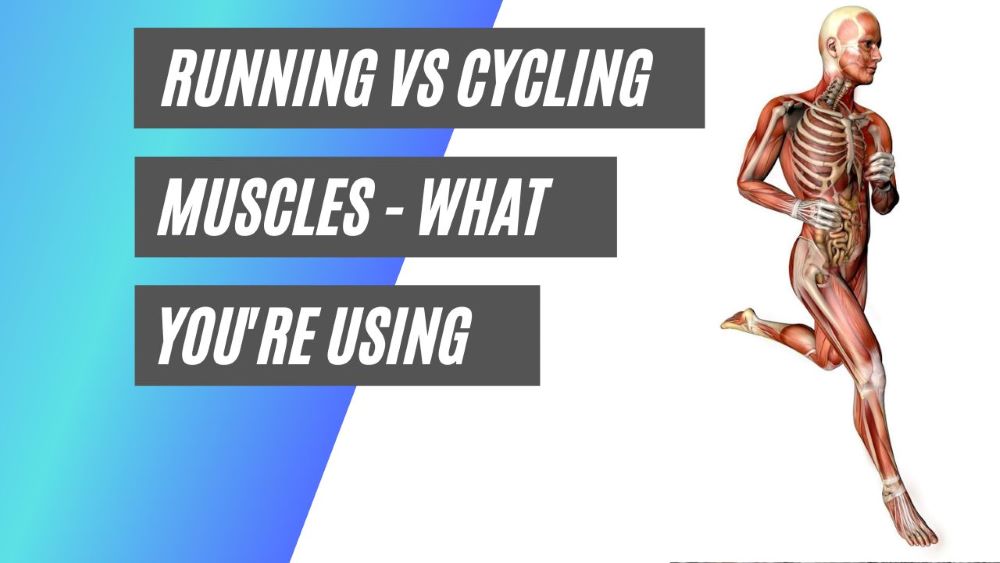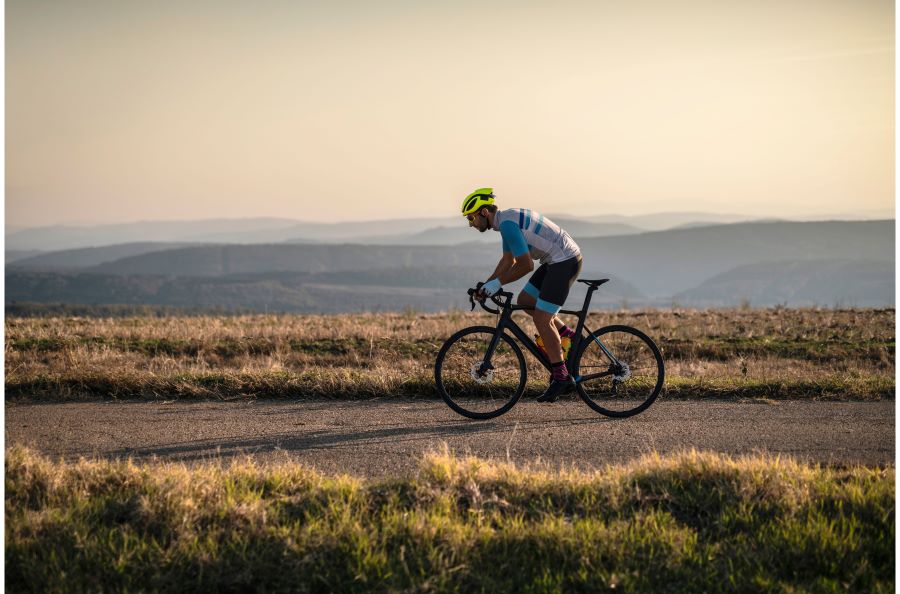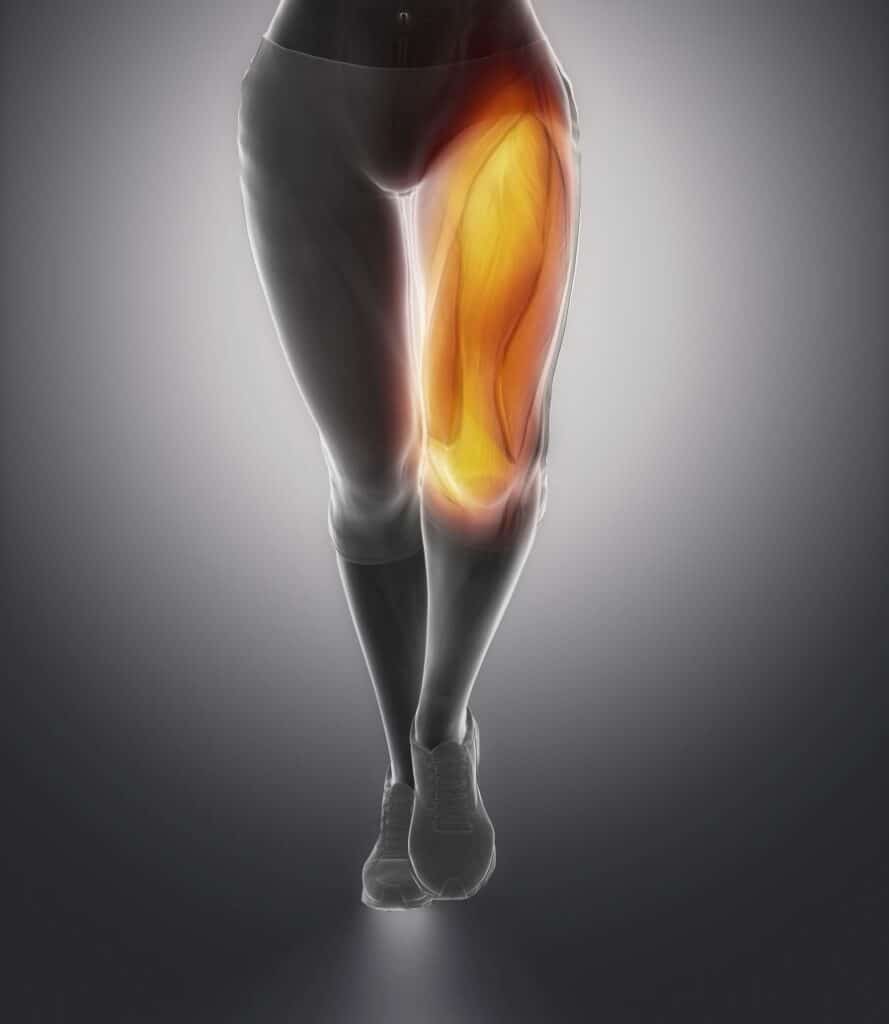This post may contain affiliate links. If you click an affiliate link and make a purchase, I may earn a commission. Also, as an Amazon Associate, I earn from qualifying purchases.--
Incredible fact – both cycling and running use every leg muscle. My jaw was on the floor when I heard that!
However, (and here’s the technical bit) they activate separate muscle groups.
Running is a more balanced yet slower form of exercise than cycling, which places more strain on certain leg muscles, allowing you to tone them better. This explains in part why bicycling and running are complementary activities.
In a nutshell, these are the muscle used for cycling and running:
The hips, hamstring, heel flexor muscles, shoulders, back, and to a lesser extent, the thighs, are primarily responsible for producing running motion. In contrast, cycling is a quad-dominated activity that also relies on the pelvic flexor muscles to allow spinning.
In this article, I’m going to examine the various muscle groups and how they are used in each activity in order to comprehend how the two sports vary.

What Muscle Groups Do Both Activities Use?
During running and cycling, these are the most utilized muscles in the body:
- The quadriceps (muscles in front of the thighs that stretch the leg at the kneecap) and the hamstrings are the most active
- The hamstrings (muscles somewhere at the rear of your thighs that stretch your leg just at the knee joint, bringing your ankles closer to your rear).
- Hip flexors (muscles at the top of the thigh that flex the leg at the hip joint – imagine bringing the knees to the chest)
- Glutes (the hip and butt musculature responsible for leg extension at the hip socket)
- Calves (the musculature at the rear of the lower thighs that flex the foot behind the ankle)
- The muscle anterior to the tibia (musculature at the front side of the leg that flexes our feet at the front side of the ankle)
Consider how these muscles make it possible for humans to run; the running stroke of one leg may be broken down into several parts.
Deep Dive into Each Muscle Group
The Quadriceps and Hamstrings
The top and back thigh muscles, the quads, and the hamstring, are used in both biking and running.
When cycling or running, your quadriceps elevate the leg for a step while your hamstrings bring the legs down eventually.
When you are running, the key muscles used are the thighs.
When cycling, this musculature is vital to the biomechanics of pedaling, although they are not the primary source of power for pedal rotation when pedaling correctly.
The Gluteal Tendons
Cycling is driven by the glutes.
Although your thighs tighten to turn the pedals, the power of the rotation originates from your buttocks.
When you jog, your glutes contribute to the propulsion of your stride to maintain the amplitude and velocity of your stride, but these are predominantly leg functions.
Runners and bikers should exercise and stretch their hip flexors to promote glute growth.
The Calves
In bicycling, the calves aid in pedaling by guiding the foot as necessary.
Although the calves promote knee flexion during the pedal revolution, other muscles are far more important.
Significantly more than bikers, runners depend on their calves as a key source of producing force. The calf flexes the knees and ankles without any assistance from pedaling or the upper thighs and contributes to the acceleration of the runner.
The Abdomen
The abdominal muscles aid runners and cyclists in controlling their breathing, which impacts their endurance and speed.
However, runners depend on their cores more than bikers. When you run, your abdominal muscles help you maintain your balance, however, when you cycle, your spine and the bike provide the needed support.
The Arms
The musculature in the front and rear of the forearms, the biceps, are sustaining muscles both for joggers and bicyclists.
During running, each bicep drags the arm back in resistance to the rising quadriceps, followed by the triceps pulling the arm forward to assist in propulsion as the hamstrings complete the stride.
On a bike, your arms do somewhat less labor than when you jog, but they aid with steering and body balance.
The Heart is a Muscle Too
Running and bicycling are equally healthy for cardiovascular health. Aerobic exercises strengthen the heart, allowing it to pump more oxygen throughout the body. Cardiovascular activity, including running and cycling, trains the heart to pump more effectively at all other times.
If you run or bike vigorously for more than 60 minutes every day, you might need to reduce your activity.
According to a meta-analysis of several research studies, strenuous exercise that exceeds 5 hours per week or 60 minutes per day may have a deleterious impact on your cardiovascular health.
A little physical activity may have enormous advantages for practically everyone.
However, if you suffer from a chronic medical issue, you should see your doctor to ensure that your chosen exercise is appropriate for you before engaging in it.
For example, if you suffer from diabetes, excessive exercise may raise your chances of having low blood sugar levels and ketoacidosis, a potentially fatal consequence.

Table Of Muscles Usage In Running Vs Cycling
| Muscle | Use In Cycling | Use In Running | Importance in Cycling | Importance in Running |
| Quadriceps | Elevate the leg for pedalling | Raise leg | Medium | High |
| Hamstrings | Push the leg down | Take weight of body above knee and propel forward | Medium | High |
| Gluteal Tendons | The source of power of your rotation | Propel your legs forward | High | Medium |
| Calves | Guiding the foot | Providing power | Low-Medium | High |
| Abdomen | Helping with breathing | Maintaining balance | Low-Medium | Medium-High |
| Arms | Aid with body balance and steering | Aid with balance and rhythm | Medium | Medium |
What are the Different Components of a Run?
- Initial interface: In front of you, the leg strikes the ground. As the body goes forward over the leg, the quadriceps are employed to counteract the forces generated by the knee flexing.
- Mid Position: To continue to move your body over the leg, you stretch your hips (engaging your glutes). Calves function to balance the weight over the foot.
- Launch off: The leg stretches as your body continues to lean over it.
- Beginning Swing: To prepare your leg to swing forward, you bend your knee cap (using your hamstrings).
- Mid Swing: Your leg is swung forward by flexing your hip (using your core muscles). To avoid tripping, the tibialis posterior muscle flexes to elevate the foot.
- Swing to Completion: You extend your knee and foot (using your quadriceps and calves once again) in preparation for first contact once more.
The Bottom Line: While running employs all the leg muscles, the glutes and hip flexors coordinate the majority of leg motions.
What are the Different Components of Cycling?
In one rotation of the pedals using the metaphor of a clock swing, the following occurs:
- Commencement of the Power Stage: This takes place from 12 noon, or the peak of the rocking motion, until around 3 o’clock. The hip expands (using the glutes) to begin pressing down on the pedal.
- The Apex of the Power Stage: This takes place between the hours of 3 and 5. This is when the knee is stretched (using the quadriceps) to continue pushing down on the pedals. This portion of the downstroke is the strongest.
- Fulfill the Power Stage: Between 5 and 6 o’clock, or the lowest point of the down stroke, you enter the power stage. This phase employs the calves to sustain the force transferred from the upper thighs toward the rotors (it also keeps your feet on the pedals).
- Commencement of the Recovery Stage: Occurs between 6 and 8 o’clock. From the power phase, the situation is essentially inverted. The tibialis anterior muscular units are used in place of the calf muscles.
- The Recovery Phase’s Midpoint: Takes place between the hours of 8:00 and 10:00. To bend the knee, the hamstrings, which oppose the quadriceps, are used.
- Finishing the Recovery Phase: Starts from 10 o’clock and lasts till 12 noon. The hip flexors finish the cycle as the opposing muscle group of the glutes.
Certain muscular areas are used much more during cycling, as the naming scheme of the stages suggests.
Different Cycling Styles
While running mostly remains the same for everyone, the kind of cycling you pick will also determine which muscles are used.
In road racing and time trialing, most of the time is spent in a stationary posture, which may lead to aches and discomfort if your setup is incorrect.
Mountain biking is mostly about balance and posture on the bicycle, while a sprinter producing large watts from the seat will also use their arms and back.
This is also true when climbing without a saddle, whenever the legs and spine will be more stretched than while you are seated.
It is essential that your posture on the bike supports efficient riding; if you are leaning too flat and too far back, you will not be able to effectively activate your primary muscles, especially your hip extensors, which are the strongest muscles in the body.
You should be positioned like a triathlon, high and front. This is also helpful for preventing knee soreness and optimizing cadence.
Different Running Styles
Running engages numerous distinct leg muscle groups.
When employing proper techniques, marathon runners will utilize the quadriceps, hamstrings, buttocks, groin, and calves.
Everything is up for grabs. However, unless the individual is a sprinter, really no specific muscle will be dominant. What wins marathons is a well-balanced, almost monotonous, leg effort.

Fatigue and the Possibility of Muscular Injury
Muscle Groups experience Neuromuscular Fatigue differently
Since the kind of muscular contractions and the risk for muscle injury varies among biking and running, the neurological exhaustion generated by prolonged exercise likely comes from distinct regions (center vs. periphery) and causes varying degrees of strength loss.
With running, the strength loss and time needed to reach the point of exhaustion are related to the impact and length of the training program.
In bicycling, for instance, in which there is less contact, tiredness is determined more by the amount of force produced and the increase in muscle activity.
What about Cycling Muscle Injuries?
Cycling puts less burden on muscles than numerous other types of exercise, therefore, it is less probable that you may strain a muscle.
However, there is a greater danger of repetitive strain injuries and aches and pains from keeping the same posture for extended periods if your bike setup is incorrect, thus, a bike fit should be considered carefully.
The leading cause of injury in cycling is knee discomfort. Knee discomfort is mostly caused by improper bike fit, followed by damage from an accident.
Biomechanical issues resulting from muscular imbalance are also a concern and are often exacerbated by overtraining. It is essential to emphasize the importance of increasing mileage gradually and integrating stretches and exercises like squats into your regimen.
What Does the End Result Look Like?
Runners Have Often Less Vascularized Legs
This is among the most obvious contrasts between runners and bikers. You will often discover that bikers have vascular legs, as a consequence of all the oxygen that is pushed to the musculature when they ride swiftly and intensely.
Cyclists often refer to their legs as having “spider veins” when the arteries are so near to the skin’s surface that they resemble spider webs. It is pretty comparable to weightlifting in the gym.
Runners will not get as much blood circulation to their legs due to the fact that they are not engaging in the same sort of strenuous workout.
Runners’ legs are often less vascular than those of cyclists due to reduced blood flow.
However, some athletes may have more cardiovascular capacity than others, depending on individual genetics and training. Shaving is a simple way to seem more vascular. Shaving the legs or any other body area will increase the visibility of veins.
Advanced Bikers’ Legs May Resemble Those of Bodybuilders More
If you have ever seen professional or even novice bicyclists in person or on television, you may have noticed that their legs resemble those of bodybuilders.
This is due to the fact that there are two primary kinds of muscle tissues being used: slow-twitch and fast-twitch. At greater cadences, bicyclists utilize more fast-twitch muscle tissue to generate more power and strength.
When weightlifting, bodybuilders also employ more fast-twitch muscle tissue to produce larger muscles. Due to this, you will see many similarities between the two groups, including chiseled and defined legs.
Why You Might Feel Sore After Running
Ever wondered why you are frequently sore during the first seven days of running, and why your stride and running form seem inefficient?
This poor movement will also affect how challenging running feels and the amount of force you can generate.
The musculature that comes into action during the shift from bicycling to running needs time to adjust to the increased motion and tension, and it is important to understand it.
Final Thoughts
Much of the same musculature is used in both running and cycling, but each sport pushes the person in a unique way.
Recognizing the significance of each specific muscle in both disciplines may improve performance and lessen the risk of injury for triathletes and other cross-trainers. This piece should have instructed you about how to identify and best use each muscle used in each of these tasks.
